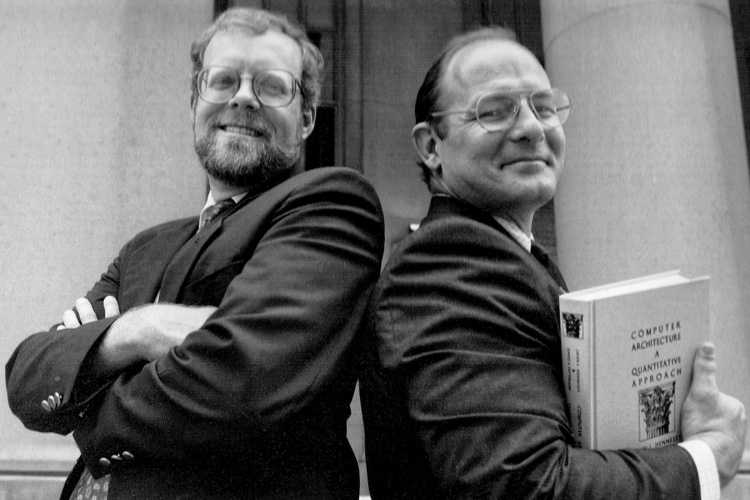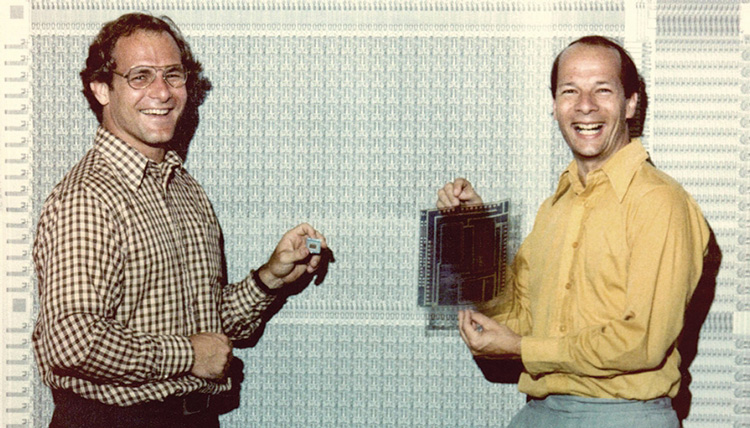David Patterson, pioneer of modern computer architecture, receives Turing Award

The Association for Computing Machinery (ACM) today named David A. Patterson, professor emeritus of the University of California, Berkeley, and John L. Hennessy, former president of Stanford University, recipients of the 2017 ACM A.M. Turing Award for pioneering a systematic, quantitative approach to the design and evaluation of computer architectures with enduring impact on the microprocessor industry.
Patterson and Hennessy are honored for their creation of an approach to designing faster, lower-power and reduced instruction set computer microprocessors, known in their field as RISC processors. Today, 99 percent of the more than 16 billion microprocessors produced annually are RISC processors, and they are found in nearly all smartphones, tablets and the billions of devices that comprise the Internet of Things. Patterson and Hennessy laid out their principles in their influential book, Computer Architecture: A Quantitative Approach, now in its sixth edition and studied by generations of engineers and scientists who have adopted and further developed their ideas.
The Turing Award carries a $1 million prize, with financial support provided by Google. The award is named for Alan M. Turing, the British mathematician who articulated the mathematical foundation and limits of computing. Patterson and Hennessy will receive the award at an awards banquet on Saturday, June 23, 2018, in San Francisco.
“I am thrilled to share this high honor with my longtime friend and collaborator John Hennessy,” Patterson said. “UC Berkeley is among the leading universities with Turing laureates among its faculty and alumni, so my share of this award is really recognition of my good fortune of having built my career here. It has been a privilege to collaborate for four decades with the wonderful students and faculty of UC Berkeley just as the university celebrates its 150th birthday.”
Patterson’s award makes him the sixth Turing laureate among UC Berkeley’s faculty. In addition, there have been nine Turing award winners among UC Berkeley’s alumni, which is more than any other university.
RISC made chips work faster with fewer transistors
Patterson and Hennessy’s work is credited with firmly establishing the feasibility of the RISC approach, popularizing its concepts and introducing it to academia and industry. The RISC approach differed from the prevailing computers of the time, called complex instruction set computers (CISC), in that RISC requires a small set of simple and general instructions for computing functions, thus requiring fewer transistors and reducing the amount of work a computer must perform.

John Hennessy and David Patterson circa 1991, upon publication of their groundbreaking book on computer architecture. (Shane Harvey photo)
In the ACM press release announcing the Turing Award, Bill Gates, principal founder of Microsoft Corporation, said the contributions of Patterson and Hennessy “have proven to be fundamental to the very foundation upon which an entire industry flourished.”
Patterson’s Berkeley team, which coined the term RISC, built and demonstrated their RISC-I processor in 1982. With 44,000 transistors, the RISC-I prototype outperformed a conventional CISC design that used 100,000 transistors. Later, the Berkeley team’s work was commercialized by Sun Microsystems in its SPARC microarchitecture. By the mid-1990s, RISC microprocessors were dominant throughout the field.
“This is a tremendous and richly deserved honor for two intellectual leaders in the computer science field, who not only consistently developed industry-transforming ideas spanning decades, but have also been outstanding teachers and disseminators of their quantitative approach to computer architecture through their enormously successful textbooks,” said Randy Katz, vice chancellor for research at UC Berkeley. “They are the leading computer architects of their generation, and they serve as research, teaching and service role models in academic excellence for the entire computer science field. And their collaboration shows that indeed, there is something that Berkeley and Stanford can agree on.”
Enabling the ‘Internet of Things’
Patterson and Hennessy’s1990 textbook, Computer Architecture: A Quantitative Approach, has influenced generations of engineers and, through its dissemination of key ideas to the computer architecture community, is credited with significantly increasing the pace of advances in microprocessor design. In Computer Architecture, Hennessy and Patterson encouraged architects to carefully optimize their systems to allow for the differing costs of memory and computation. Their work also enabled a shift from seeking raw performance to designing architectures that take into account issues such as energy usage, heat dissipation and off-chip communication. The book was groundbreaking in that it was the first text of its kind to provide an analytical and scientific framework, as well as methodologies and evaluation tools, for engineers and designers to evaluate the net value of microprocessor design.

“ACM initiated the Turing Award in 1966 to recognize contributions of lasting and major technical importance to the computing field,” said ACM President Vicki L. Hanson. “The work of Hennessy and Patterson certainly exemplifies this standard. Their contributions to energy-efficient RISC-based processors have helped make possible the mobile and IoT revolutions. At the same time, their seminal textbook has advanced the pace of innovation across the industry over the past 25 years by influencing generations of engineers and computer designers.”
Patterson was a professor of computer science at UC Berkeley from 1976 to 2016 and is now a professor of the graduate school and a distinguished engineer at Google. He also serves as vice chair of the board of the RISC-V Foundation, which offers an open, free instruction set architecture based on Berkeley research with the aim to enable a new era of processor innovation through open-standard collaboration. Patterson received his bachelor’s, master’s and doctoral degrees in computer science from UCLA.
With today’s award, Patterson is the first Turing laureate to have also earned recognition from ACM in three other prestigious award categories. In 1991, Patterson’s course series on RISC and his novel approach to teaching computer science to non-majors earned him ACM’s Karlstrom Outstanding Educator Award. And in 2008, he earned an ACM Distinguished Service Award for his service and contributions to the computing community, and an ACM-IEEE CS Eckert-Mauchly Award for his contributions to computer and digital systems architecture.
Patterson’s other honors include the IEEE John von Neumann Medal (with Hennessy) and the Richard A. Tapia Award for Scientific Scholarship, Civic Science, and Diversifying Computing. Patterson served as ACM President from 2004 to 2006. He is a Fellow of ACM, the American Association for the Advancement of Science and IEEE, and was elected to the National Academy of Engineering and the National Academy of Sciences.
